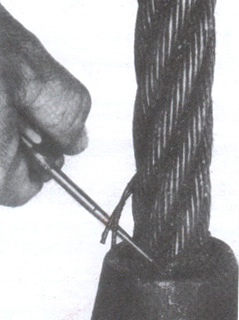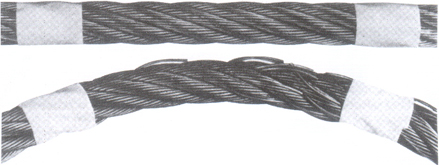|
|
 |
| When to Replace Wire Ropes? |
| |
Running Ropes |
Standing Ropes |
| |
No. Broken Wires in Standard Ropes |
No. Broken Wires in Rotation Resistant Ropes |
No. Broken Wires |
| Standard |
Name |
In all strands
in one
Rope Lay |
In one
strand in one
Rope Lay |
|
In all one Rope Lay |
At End Connections |
| ASME/B 30.2 |
Overhead & Gantry Cranes |
12** |
4 |
|
- |
- |
| ASME/B 30.4 |
Portal, Tower & Pillar Cranes |
6** |
3 |
4 in all strands in one rope lay or 2 in one strand in
one rope lay |
- |
- |
| ASME/B 30.5 |
Crawler, Locomotive & Truck Cranes |
6** |
3 |
2 in 6 rope diameter or 4 in 30 rope diameters. |
3 |
2 |
| ASME/B 30.6 |
Derricks |
6** |
3 |
--- |
3 |
2 |
| ASME/B 30.7 |
Base Mounted Drum Hoists |
6** |
3 |
--- |
3 |
2 |
| ASME/B 30.8 |
Floating Cranes & Derricks |
6** |
3 |
--- |
3 |
2 |
| ASME/B 30.16 |
Overhead Hoists |
12** |
4 |
2 in 6 rope diameters or 4 in 30 rope diameters |
- |
- |
| ANSI/A 10.4 |
Personnel Hoists |
6** |
3 |
|
2** |
2 |
|
** For rope operating on steel sheaves and drums. Contact the have, drum, equipment manufacturer or a qualified person for removal criteria for wire ropes operating on sheaves and drum made of material other than steel.
** Also remove for 1 valley break (at strand-to-stmd contact point) or one protruding or looped wire broken strand-to-core contact point.
Wire breaks generally are seen in two location
on a rope; at the crowns of outer strands and in the valley between outer strands.

Crown Wire Breaks

Valley Wire Breaks
|
|
Crown wire breaks usually are due to normal wear and typically have square ends. Valley breaks may indicate an abnormal condition, such as loss of core support, small sheave grooves or deterioration from unusually heavy rope loading.
When a wire has broken from excessive loading or a tensile overload, the ends of the wire will be pulled or necked down in diameter on each side of the break, in contrast to the typical square ends of crown wire breaks. In normal service, the wire breaks will exhibit characteristics of both axial loading and fatigue.
A wire broken under a tensile load that exceeds its strength is recognised by the "cup and cone" configuration at the fracture point (a) The necking down of the wire at this point shows that failure occurred while the wire retained its ductility. Shear-tensile fracture (b) usually exhibiting an angular flat plane failure surface, occurs in wire subjected to a combination of transverse and axial loads. Fatigue breaks are usually characterised by squared-off ends perpendicular to the wire either straight across or Z-shaped (c&d).
|
|

Wire Breaks at End Termination
|
TYPES OF WIRE BREAKS
As a wire rope moves over sheaves and drum, each strand and each wire in every strand moves and adjusts. Bending the rope or observing it moving slowly over a sheave can help the inspector find broken wires.
Once wire breaks appear, their number will increase if the rope continues in service.
Valley and strand-to-core contact point breaks are difficult to detect in a rope and must be taken very seriously. These types of- wire breaks are indicative of conditions that results in internal degradation occurring at a faster rate than external degradation.
Wire Breaks at rope Termination are also indicators of rope degradation. A single broken Wire at a termination is usually reasons to question continued use of a rope; more than one break is usually sufficient reason to remove the rope from service.

Flexing a rope can often exposed broken wires hidden in valley between strands
|
|
|
|
|
|
|